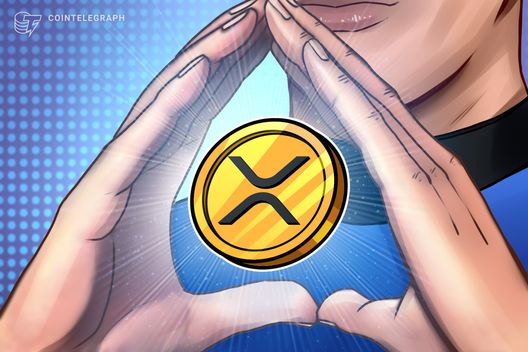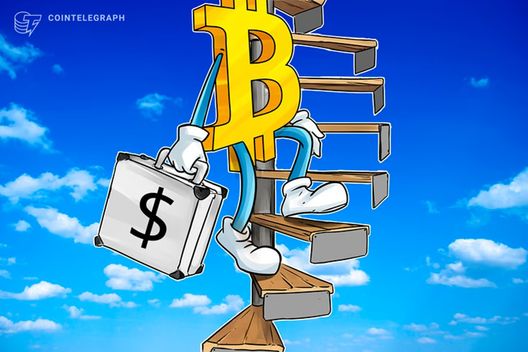
Die Marktkapitalisierung von XRP ist 2.200 Mal höher als sein gesamter gesperrter Gesamtwert auf XRPL. Trader halten das für ein gutes Signal.

Finanzmittel Info + Krypto + Geld + Gold
Krypto minen, NFT minten, Gold schürfen und Geld drucken

Die Marktkapitalisierung von XRP ist 2.200 Mal höher als sein gesamter gesperrter Gesamtwert auf XRPL. Trader halten das für ein gutes Signal.
Bitcoin Cash (BCH) is not one of the flashy performers in the crypto market, with the coins’ 18% uptick in the past month small compared to peers in the top 100 cryptocurrencies by market cap.
However, as Ethereum makes headlines as it approaches its all-time high, Bitcoin Cash is also hovering around a critical resistance level having tested the $600 level.
This charge, fueled by a remarkable 30% surge in daily trading volume, could see BCH eye further gains towards the $1,000 mark. But what’s the technical outlook?
The price of Bitcoin Cash is currently retesting a pivotal resistance zone, with its price hovering around the $600 mark.
Over the past 24 hours, BCH has touched highs of $601 across major exchanges, and shows resilience with prices remaining above $590 and ticking to highs near the July peak of $604.

The jump to $600 represents a notable move for BCH, as this allows buyers to test the upper boundary of a sell wall that has previously seen bears emerge strongly.
Notably, the 30% spike in trading volume speaks to the increased market activity, suggesting traders may be positioning for a potential breakout.
BCH price reached highs of $624 in December 2024 and last traded above $1,000 in 2021.
Looking at the technical picture for Bitcoin Cash, the overall outlook is optimistic, with bulls setting their sights on flipping $600 into a robust support level.
From here, a potential climb towards $1,000 is possible. In the short term, the supply wall is around $680 and $764 and above this, a flip to $1k and over will be more likely.
The broader market sentiment, with Fear & Greed Index trending in the “Greed,” zone, adds to this outlook.
BCH’s technical indicators also align with a bullish trend. Increased adoption that has investors buoyed amid favorable macroeconomic conditions, gives this altcoin a good chance of continuing higher.
However, traders may yet trade cautiously as profit taking a dump for major altcoins could dampen broader sentiment.
The upcoming inflation data, with Bitcoin’s correlation with stocks tight, could mean either a sharp surge or notable dump.
“BTC ’s correlation with equities has tightened since mid-July, mirroring US stocks’ rebound to near record highs. Attention now shifts to Tuesday’s CPI, expected to rise 10 bps to 2.8%,” analysts at QCP noted. “A softer CPI could cement odds of a September Fed cut, while a hotter print risks stalling the rally. Traders are hedging with demand for short-dated $BTC puts in the $115k–$118k range.”
The price of Bitcoin hovers around $118,500, while BCH trades near $590.
The post BCH looks to break key resistance as Bitcoin Cash volume jumps 30% appeared first on CoinJournal.

Bitcoin konnte gestern fast sein Allzeithoch erreichen. Nun bekräftigt ein Experte seine bullische Prognose – jeder brauche in 2025 Bitcoin.
The legal fallout from the spectacular collapse of cryptocurrency exchange FTX has now zeroed in on the Fenwick & West law firm.
Plaintiffs in a massive class action are accusing Silicon Valley-based law firm of being far more than a bystander in the $8 billion fraud that brought down Sam Bankman-Fried’s empire.
The plaintiffs allege that the prestigious firm not only knew about FTX’s misconduct but also actively shaped the structures that made it possible.
The class action, filed on Monday, is part of a multi-district litigation involving more than 130 firms linked to FTX, and it singles out Fenwick & West as the only one accused of knowingly participating in the fraud.
Plaintiffs say new evidence from Bankman-Fried’s criminal trial and the bankruptcy investigation reveals the firm played a “key and crucial” role in the exchange’s operations.
According to them, FTX’s massive misappropriation of customer funds could not have happened without Fenwick’s “substantial assistance.”
Court filings claim the firm designed corporate entities with no safeguards, enabling FTX to divert billions in customer assets to its sister trading firm Alameda Research.
Among the most controversial allegations is that Fenwick set up shell companies such as North Dimension to obscure transactions, drafted backdated agreements to justify illicit transfers, and approved intercompany loans secured by customer funds.
Prosecutors and bankruptcy examiners have accused FTX executives of using disappearing messages on Signal to cover their tracks.
Plaintiffs now allege that Fenwick itself authored the encrypted communications policy that allowed those messages to vanish.
The firm is also accused of creating auto-deleting chat channels for executives and engaging in other practices that regulators later described as obstruction.
Nishad Singh, FTX’s former engineering director, testified that he personally informed Fenwick about the misuse of customer funds and false disclosures. He claims the firm responded not with warnings but with guidance on how to hide the wrongdoing.
Similar testimony from former Alameda CEO Caroline Ellison and co-founder Gary Wang supported the narrative that Fenwick was aware of the diversion of funds to cover Alameda’s losses.
The independent examiner in the FTX bankruptcy case reviewed more than 200,000 documents, many directly related to the Fenwick & West law firm.
The examiner’s report concluded the firm was “deeply intertwined” in nearly every aspect of FTX’s misconduct. It also described “exceptionally close relationships” between Fenwick’s lawyers and FTX insiders, alongside evidence of the firm facilitating conflicted transactions that misused customer assets.
These findings have intensified scrutiny on the firm’s role in promoting FTX’s credibility to investors.
Plaintiffs argue Fenwick’s Silicon Valley reputation helped the exchange raise more than $1.3 billion from venture capitalists, despite internal knowledge of insolvency risks.
The amended complaint also adds state securities law claims in Florida and California, accusing Fenwick of promoting and facilitating unregistered sales of FTT tokens and yield-bearing accounts.
The Fenwick & West law firm has consistently denied all allegations, insisting it acted within the scope of its legal representation.
In its 2023 motion to dismiss, the firm argued that attorneys cannot be held liable for a client’s misconduct when their actions fall within their professional role.
The court has yet to rule on Fenwick’s latest bid to have the claims thrown out, and a request from plaintiffs to amend their complaint with fresh evidence is pending before US District Judge K. Michael Moore in Miami.
As the litigation unfolds, the case is being watched closely by the legal and crypto industries alike.
A ruling against the Fenwick & West law firm could set a precedent for attorney liability in the digital asset space, reshaping how law firms approach high-risk clients.
For FTX’s creditors, the outcome could influence how much more, if anything, can be recovered from the wreckage of one of the largest financial collapses in US history.
The post Fenwick and West law firm sued over alleged role in FTX’s multibillion-dollar theft appeared first on CoinJournal.
Ripple’s legal battle with the US Securities and Exchange Commission (SEC) concluded last week, ending years of uncertainty over whether XRP should be classified as a security.
The outcome was expected to boost investor confidence, but XRP has instead fallen 4% today, underperforming most other major altcoins.
The unexpected drop has prompted questions about market behaviour and the impact of regulatory developments on token prices.

While the SEC now signals a shift towards developing clearer cryptocurrency rules, market reaction suggests traders may be waiting to see how these proposals translate into policy before making long-term commitments.
Following the settlement, Ripple’s chief technology officer, David Schwartz, marked the moment with a Monty Python reference on X.
Posting a GIF from the “Salad Days” sketch, Schwartz chose a scene where a character cheerfully declares, “What a simply super day” before chaos unfolds.
The post came just days after the SEC wrapped up the prolonged case against Ripple, a lawsuit that had shaped much of the discussion around crypto regulation in the United States.
The dispute focused on whether XRP constituted a security under federal law.
Its resolution was widely expected to remove a significant source of uncertainty for Ripple and its investors.
With the case closed, SEC Chair Paul Atkins and Commissioner Hester Peirce stated they intend to work towards “clear rules of the road” for digital assets.
Ripple’s chief legal officer, Stuart Alderoty, acknowledged the development on X, expressing support for a move towards regulatory clarity.
This represents a notable change in the SEC’s tone, moving from enforcement-driven actions to signalling interest in proactive regulation.
Industry participants have long called for consistent guidelines, arguing that ambiguity in the current framework hinders innovation and deters institutional investment.
Despite expectations of a sustained rally, XRP’s price trajectory has moved in the opposite direction.
The token surged in the immediate aftermath of the legal outcome, but gains were short-lived.
Traders appear to have adopted a “buy the rumour, sell the news” approach, a common pattern in cryptocurrency markets where prices rise in anticipation of a positive event and then fall as investors lock in profits.
The current decline also suggests some market participants may be cautious, preferring to assess the SEC’s forthcoming regulatory proposals before re-entering or increasing exposure to XRP.
Questions raised on X by traders highlight the puzzlement over the drop, given the removal of legal uncertainty that had weighed on the asset for years.
The combination of profit-taking, short-term sentiment, and anticipation of regulatory details appears to be driving the subdued market response.
Until further policy clarity emerges, XRP’s price may remain influenced by both macro-level regulation news and speculative trading behaviour.
The post Why XRP price has failed to breakout despite SEC settlement appeared first on CoinJournal.